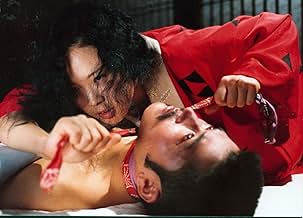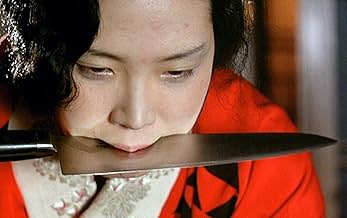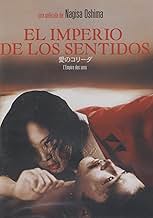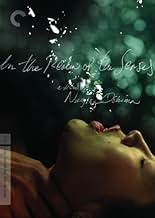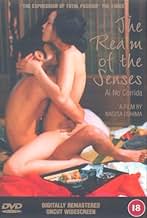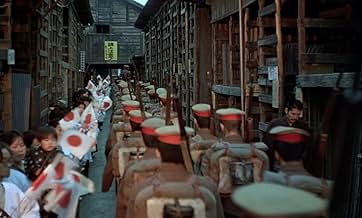यह सदा अबे की कहानी के बारे में दर्शाती है. एक भावुक महिला, जिसका अपने मालिक के साथ प्रेम प्रसंग था और अंत में विनाशकारी यौन संबंध बन जाता है.यह सदा अबे की कहानी के बारे में दर्शाती है. एक भावुक महिला, जिसका अपने मालिक के साथ प्रेम प्रसंग था और अंत में विनाशकारी यौन संबंध बन जाता है.यह सदा अबे की कहानी के बारे में दर्शाती है. एक भावुक महिला, जिसका अपने मालिक के साथ प्रेम प्रसंग था और अंत में विनाशकारी यौन संबंध बन जाता है.
- पुरस्कार
- कुल 4 जीत
फ़ीचर्ड समीक्षाएं
Nagisa Oshima has achieved what few other directors have managed in dealing with the very touchy subject of sex, in this instance, with sexual obsession. If you plan to watch this movie for a cheap sexual thrill, you will be most disappointed. Oshima has drawn from a real incident reported in a 1936 Japanese newspaper. The film centers around the love between two people expressed physically, graphically, into realms of the senses where few dare to tread. And with good reason. This is a very intense film as it progresses from the attraction of two people through increasing experimentation in an effort not only to express their passion but to try to find the outer most limits of passion itself. Oshima must have had something metaphorical in mind but the journey as chronicled in the film also has retained the feel of the specifics. It's quirkey and eccentric. The backdrop of the story is as interesting as the story itself. It is an amazing spectacle to observe, giving the viewer a perspective on Japanese life not usually rendered but often alluded to in some historical accounts. One wonders what this experience must have been like for the actors. Oshima has managed what I have always believed should be done in order to treat the subject of sex fully and without shrinking from its' less savory aspects. This is serious minded erotica and quite unlike anything else on screen. The only other film I can recall that compares at all is "Taxi Zum Klo" which was autobiographical and starred a number of actual people playing themselves.Obviously a different catagory in that regard from what is going on here, but both films draw much of their power from explicitly sexual scenes without compromising the integrity of the story being told. This is a film experience that should not be missed.
With his landmark film The Ceremony, Nagisa Oshima became one of Japanese filmdom's leading social critics as he dissected the logic behind ritual suicide, arranged marriages and other activities considered acceptable 'traditional' behavior. Here he examines the story behind a famous Japanese scandal - a prostitute was found wandering the streets of Tokyo out of her mind following the death of her lover by erotic asphyxiation - in terms of what is considered 'acceptable' Japanese social behavior. The principals engage in obsessive sexual activity, and allow the addictive and dangerous aspects of their relationship to get out of hand precisely BECAUSE it was considered so unhealthy and immoral by Japanese standards. In a society in which all sexual activity is viewed as shameful, shame no longer mediates behavior. Limits become meaningless. The film itself is colorfully made, with excellent period detail and production design, and the actors are attractive. The structure is that of an erotic novel, as game playing, obsession and danger escalate to a fitting point-of-no-return climax. It is much better and more socially relevant than similar American films such as Nine 1/2 Weeks.
IN THE REALM OF THE SENSES explores sexual obsession and the extremes to which it drives the characters. I saw the uncut version,readily available at the Cleveland Public Library. It was indeed sexually graphic,reaching a point where the act seems to be driven by a kind of symbiosis that can only culminate in one way. The ending is one of the most horrifying things I've ever seen in a movie. Do not confuse
this movie with the vastly inferior IN THE REALM OF PASSION.
this movie with the vastly inferior IN THE REALM OF PASSION.
Sure, everyone (or most everyone) has heard about "Sex, Lies, and Videotape" and its remarkable statement about human sexuality. However, it is unlikely that as many people have heard about this film, which in a totally different way makes perhaps as profound a statement about that topic.
In fact, if you see an uncut version of this film, you are in essence watching pornography. That is, you are watching incredibly graphic sexual content that simply would not be allowed in an American film. I won't spell it out for you, but I will say this...do you know what they can't show you in American movies? This one shows that. And quite a bit more. This is not the type of sex you would see in a film like "Sex, Lies, and Videotape" or "Bliss" or some of the other decent American films about sex (though I can't think of any others). This is more like the sex shown in "Last Tango in Paris." The characters are so self-destructive and dangerous that the sex (one of the most inherent of all human practices) becomes an expression of their inhumanity. This is not easy stuff. But if you are willing to find an uncut version and experience the true power of this film, you may find yourself moved by the things you see.
This film blurs the line between pornography and art, and I believe that it stays one inch to the art side, but decide for yourself. Either way, I think that it is about time for American films to truly explore that distinction.
In fact, if you see an uncut version of this film, you are in essence watching pornography. That is, you are watching incredibly graphic sexual content that simply would not be allowed in an American film. I won't spell it out for you, but I will say this...do you know what they can't show you in American movies? This one shows that. And quite a bit more. This is not the type of sex you would see in a film like "Sex, Lies, and Videotape" or "Bliss" or some of the other decent American films about sex (though I can't think of any others). This is more like the sex shown in "Last Tango in Paris." The characters are so self-destructive and dangerous that the sex (one of the most inherent of all human practices) becomes an expression of their inhumanity. This is not easy stuff. But if you are willing to find an uncut version and experience the true power of this film, you may find yourself moved by the things you see.
This film blurs the line between pornography and art, and I believe that it stays one inch to the art side, but decide for yourself. Either way, I think that it is about time for American films to truly explore that distinction.
I saw this film the first time in the movies in holland about 78; I was sitting next to a nice girl wiht her boyfriend and felt terribly upset. I knew this was very real. Not romantic at all. It shows what sex can do to people and although in the ending the dramatics are overdone to my taste; this is a classical tragedy. The acting is incredible; i think the one big problem making movies showing real sex that the actors can't cope with it. These actors could. Everybody who can't see through the pornografic explicities is sexually unfree and morally limited. This film isn't a happy one and doesn't show us the freedom that sex can bring us; it shows the slavery which sex can bring about; it's problably the best film ever about sex addiction there is. It's a problem that is hardly publicly debated; or if in the hands of Christian crusaders, who want to take us all the fun. In other critics you read about th Art question : "is this Art?" Not an important question, but for me it is; it has learnt me very much about the human condition and how we cope with it.
क्या आपको पता है
- ट्रिवियाDemand to see the film at its first appearance at the Cannes Film Festival was so high, 13 screenings were arranged.
- इसके अलावा अन्य वर्जनThe original version ran 108 minutes. Producer Anatole Dauman received Oshima's permission to recut the film, resulting in a shorter 102-minute edit. This version has been distributed theatrically in some countries (such as France) and is available on video in Australia, the UK, the United States, and France. The French DVD includes both versions (via seamless branching), while the U.S. Criterion DVD features the cut footage as an extra. The PAL releases run 97 minutes. This shorter version makes the following changes:
- An early scene in which Sada has sex with Ishida while playing a shamisen has been cut by about a minute and a half. In the original version, Sada seemingly goes unconscious and Ishida checks for her heartbeat.
- A brief shot (12 seconds) of Ishida and Sada on a bridge has been added to the scene in which the couple goes out walking at night.
- A later scene (in which the geishas assault one of their own with a dildo) is cut by 14 seconds to remove a shot of Ishida and Sada's faces in mid-copulation.
- An entire two-minute scene is deleted about an hour into the film. This scene features Sada and Ishida having sex behind a thin screen, while Ishida speaks of the "darkness" he feels inside Sada.
- The scene in which Sada first strangles Ishida is cut by just over one minute. In the short version, the scene ends when Ishida starts coughing and Sada releases his throat. In the original version, Ishida asks her to resume, which she does (only to stop when he begins coughing again).
- The scene in which Ishida becomes drowsy while having sex with Sada is edited differently. The original version has slightly different dialogue and has an additional minute of footage where Ishida actually does fall asleep for a short time.
- The scene in which Sada wakes up after her final night with Ishida is cut by one minute. The original version shows Sada lying on the floor and apparently panicking, walking around the room and opening doors for no obvious reason. The short version cuts straight from Sada waking up to the shot of her standing over Ishida's body.
- कनेक्शनEdited into Video Macumba (1991)
- साउंडट्रैकBallades for koto II-Spring: Mebae (Seeding)
Composed by Minoru Miki
टॉप पसंद
रेटिंग देने के लिए साइन-इन करें और वैयक्तिकृत सुझावों के लिए वॉचलिस्ट करें
विवरण
- रिलीज़ की तारीख़
- कंट्री ऑफ़ ओरिजिन
- आधिकारिक साइट
- भाषा
- इस रूप में भी जाना जाता है
- Ai no korîda
- फ़िल्माने की जगहें
- उत्पादन कंपनियां
- IMDbPro पर और कंपनी क्रेडिट देखें
बॉक्स ऑफ़िस
- दुनिया भर में सकल
- $569
- चलने की अवधि
- 1 घं 49 मि(109 min)
- पक्ष अनुपात
- 1.37 : 1
इस पेज में योगदान दें
किसी बदलाव का सुझाव दें या अनुपलब्ध कॉन्टेंट जोड़ें


